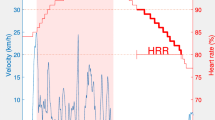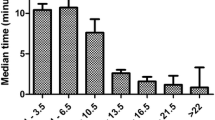Abstract
Purpose
This study aimed to compare the acute effects of uphill repeated sprinting “with long recovery” (RS) and uphill intermittent running (IR) training on heart rate (HR) and blood lactate (BL) responses.
Methods
Thirteen young male soccer players randomly performed in two separate occasions, on a slope (10 %), an RS and an IR session. RS consisted of three sets of eight maximal uphill 20-m sprints with long (90 s) recovery between sprints, and 8 min passive rest between sets, whereas IR consisted of 24 repetitions of 22-m sub-maximal (95 % of maximum speed achieved in an incremental test) uphill runs interspersed by a 15-s downhill walking recovery, lasting for a total duration of 8 min.
Results
The mean HR, expressed as the percentage of HRMAX, was significantly higher in IR than in RS (86.1 ± 3.1 vs. 77.0 ± 4.5 %, respectively, p < 0.05). Conversely, BL measured after 3 min was significantly higher in RS (5.9 ± 1.1 mmol L−1) than in IR (2.9 ± 1.2 mmol L−1, p < 0.05).
Conclusions
The differences found between RS and IR may be attributed to the different work/recovery ratios and speed characteristics. Therefore, uphill IR seems more suitable when the target is to tax the aerobic system, while RS may be more suitable when the focus is on stimulating the speed without increasing the metabolic demand.

Similar content being viewed by others
References
Carling C, Le GF, Dupont G (2012) Analysis of repeated high-intensity running performance in professional soccer. J Sports Sci 30:325–336
Elsworthy N, Dascombe BJ (2011) The match demands of Australian rules football umpires in a state-based competition. Int J Sports Physiol Perform 6:559–571
Dellal A, Hill-Haas S, Lago-Penas C, Chamari K (2011) Small-sided games in soccer: amateur vs. professional players’ physiological responses, physical, and technical activities. J Strength Cond Res 25:2371–2381
Wong DP, Carling C, Chaouachi A, Dellal A, Castagna C, Chamari K, Behm DG (2011) Estimation of oxygen uptake from heart rate and ratings of perceived exertion in young soccer players. J Strength Cond Res 25:1983–1988
Wong PL, Chamari K, Dellal A, Wisloff U (2009) Relationship between anthropometric and physiological characteristics in youth soccer players. J Strength Cond Res 23:1204–1210
Stolen T, Chamari K, Castagna C, Wisloff U (2005) Physiology of soccer: an update. Sports Med 35:501–536
Gaudino P, Gaudino C, Alberti G, Minetti AE (2013) Biomechanics and predicted energetics of sprinting on sand: hints for soccer training. J Sci Med Sport 16:271–275
Billat VL, Slawinski J, Bocquet V, Demarle A, Lafitte L, Chassaing P, Koralsztein JP (2000) Intermittent runs at the velocity associated with maximal oxygen uptake enables subjects to remain at maximal oxygen uptake for a longer time than intense but submaximal runs. Eur J Appl Physiol 81:188–196
Attene G, Pizzolato F, Calcagno G, Ibba G, Pinna M, Salernitano G, Padulo J (2014) Sprint vs. intermittent training in young female basketball players. J Sports Med Phys Fitness 54:154–161
Bishop D, Girard O, Mendez-Villanueva A (2011) Repeated-sprint ability—part II: recommendations for training. Sports Med 41:741–756
Reilly T, Williams AM, Nevill A, Franks A (2000) A multidisciplinary approach to talent identification in soccer. J Sports Sci 18:695–702
Bangsbo J, Lindquist F (1992) Comparison of various exercise tests with endurance performance during soccer in professional players. Int J Sports Med 13:125–132
Bishop D, Spencer M, Duffield R, Lawrence S (2001) The validity of a repeated sprint ability test. J Sci Med Sport 4:19–29
Reilly T (1997) Energetics of high-intensity exercise (soccer) with particular reference to fatigue. J Sports Sci 15:257–263
Wong DP, Chan GS, Smith AW (2012) Repeated sprint and change-of-direction abilities in physically active individuals and soccer players: training and testing implications. J Strength Cond Res 26:2324–2330
Rampinini E, Bishop D, Marcora SM, Ferrari Bravo D, Sassi R, Impellizzeri FM (2007) Validity of simple field tests as indicators of match-related physical performance in top-level professional soccer players. Int J Sports Med 28:228–235
Padulo J, Di Giminiani R, Ibba G, Zarrouk N, Moalla W, Attene G, Migliaccio GM, Pizzolato F, Bishop D, Chamari K (2014) The acute effect of whole body vibration on repeated shuttle-running in young soccer players. Int J Sports Med 35:49–54
Impellizzeri FM, Marcora SM, Castagna C, Reilly T, Sassi A, Iaia FM, Rampinini E (2006) Physiological and performance effects of generic versus specific aerobic training in soccer players. Int J Sports Med 27:483–492
McMillan K, Helgerud J, Macdonald R, Hoff J (2005) Physiological adaptations to soccer specific endurance training in professional youth soccer players. Br J Sports Med 39:273–277
Krustrup P, Mohr M, Amstrup T, Rysgaard T, Johansen J, Steensberg A, Pedersen PK, Bangsbo J (2003) The yo–yo intermittent recovery test: physiological response, reliability, and validity. Med Sci Sports Exerc 35:697–705
Angius L, Olla S, Piras F, Mura R, Ibba G, Todde F, Cominu M, Pinna M, Tocco F, Concu A, Crisafulli A (2013) Indexes of physical capacity and repeated sprint ability of young soccer players. Sport Sci Health 9:1–6
Bangsbo J (1994) The physiology of soccer—with special reference to intense intermittent exercise. Acta Physiol Scand Suppl 619:34–36
Morio C, Chavet P, Androuet P, Foissac M, Berton E, Nicol C (2011) Time course of neuro-mechanical changes underlying stretch-shortening cycle during intermittent exhaustive rebound exercise. Eur J Appl Physiol 111:2295–2305
Padulo J, D’Ottavio S, Pizzolato F, Smith L, Annino G (2012) Kinematic analysis of soccer players in shuttle running. Int J Sports Med 33:459–462
Padulo J, Degortes N, Migliaccio GM, Attene G, Smith L, Salernitano G, Annino G, D’Ottavio S (2013) Footstep manipulation during uphill running. Int J Sports Med 34:244–247
Padulo J, Powell D, Milia R, Ardigo LP (2013) A paradigm of uphill running. PLoS One 8:e69006
Paradisis GP, Cooke CB (2006) The effects of sprint running training on sloping surfaces. J Strength Cond Res 20:767–777
Minetti AE, Moia C, Roi GS, Susta D, Ferretti G (2002) Energy cost of walking and running at extreme uphill and downhill slopes. J Appl Physiol 93:1039–1046
Gottschall JS, Kram R (2005) Ground reaction forces during downhill and uphill running. J Biomech 38:445–452
Osgnach C, Poser S, Bernardini R, Rinaldo R (2010) Energy cost and metabolic power in elite soccer: a new match analysis approach. Med Sci Sports Exerc 42:170–178
Padulo J, Filingeri D, Chamari K, Migliaccio GM, Calcagno G, Bosco G, Annino G, Tihanyi J, Pizzolato F (2014) Acute effects of whole body vibration on running gait in marathon runners. J Sport Sci. doi:10.1080/02640414.2014.889840
Ferrari Bravo D, Impellizzeri FM, Rampinini E, Castagna C, Bishop D, Wisloff U (2008) Sprint vs. interval training in football. Int J Sports Med 29:668–674
Matsas A, Taylor N, McBurney H (2000) Knee joint kinematics from familiarised treadmill walking can be generalised to overground walking in young unimpaired subjects. Gait Posture 11:46–53
Padulo J, Annino G, Smith L, Migliaccio GM, Camino R, Tihanyi J, D’Ottavio S (2012) Uphill running at iso-efficiency speed. Int J Sports Med 33:819–823
Padulo J, Annino G, Migliaccio GM, D’Ottavio S, Tihanyi J (2012) Kinematics of running at different slopes and speeds. J Strength Cond Res 26:1331–1339
Padulo J, Annino G, D’Ottavio S, Vernillo G, Tihanyi J (2013) Footstep analysis at different slopes and speeds in Elite Racewalking. J Strength Cond Res 27:125–128
Padulo J, Annino G, Tihanyi J, Calcagno G, Vando S, Smith L, Vernillo G, La Torre A, D’Ottavio S (2013) Uphill racewalking at iso-efficiency speed. J Strength Cond Res 27:1964–1973
Ruscello B, Tozzo N, Briotti G, Padua E, Ponzetti F, D’Ottavio S (2013) Influence of the number of trials and the exercise to rest ratio in repeated sprint ability, with changes of direction and orientation. J Strength Cond Res 27:1904–1919
Taoutaou Z, Granier P, Mercier B, Mercier J, Ahmaidi S, Prefaut C (1996) Lactate kinetics during passive and partially active recovery in endurance and sprint athletes. Eur J Appl Physiol Occup Physiol 73:465–470
Astrand I, Astrand PO, Christensen EH, Hedman R (1960) Intermittent muscular work. Acta Physiol Scand 48:448–453
Pinna M, Roberto S, Milia R, Marongiu E, Olla S, Loi A, Migliaccio GM, Padulo J, Orlandi C, Tocco F, Concu A, Crisafulli A (2014) Effect of beetroot juice supplementation on aerobic response during swimming. Nutrients 6:605–615
Paradisis GP, Cooke CB (2001) Kinematic and postural characteristics of sprint running on sloping surfaces. J Sports Sci 19:149–159
Paradisis GP, Bissas A, Cooke CB (2009) Combined uphill and downhill sprint running training is more efficacious than horizontal. Int J Sports Physiol Perform 4:229–243
Padulo J, Tiloca A, Powell D, Granatelli G, Bianco A, Paoli A (2013) EMG amplitude of the biceps femoris during jumping compared to landing movements. SpringlerPlus 2
Padulo J, Dal Pupo J, Laffaye G, Chamari K (2013) Concentric and eccentric: muscle contraction or exercise? Enferm Clin 23:177–178
Padulo J, Laffaye G, Chamari K, Concu A (2013) Concentric and eccentric: muscle contraction or exercise? Sports Health 5:306
Padulo J, Laffaye G, Ardigo LP, Chamari K (2013) Concentric and eccentric: muscle contraction or exercise? J Hum Kinet 37:5–6
Padulo J, Laffaye G, Chamari K (2013) Concentric and eccentric: muscle contraction or exercise? J Sport Sci Med 12:608–609
Yokozawa T, Fujii N, Ae M (2007) Muscle activities of the lower limb during level and uphill running. J Biomech 40:3467–3475
Christensen EH, Hedman R, Saltin B (1960) Intermittent and continuous running. (A further contribution to the physiology of intermittent work.). Acta Physiol Scand 50:269–286
Angius L, Olla S, Pinna M, Mura R, Marongiu E, Roberto S, Piras F, Corona F, Milia R, Tocco F, Concu A, Crisafulli A (2012) Aerobic and anaerobic capacity of adult and young professional soccer players. Sport Sci Health 8:95–100
Paavolainen L, Nummela A, Rusko H (2000) Muscle power factors and VO2max as determinants of horizontal and uphill running performance. Scand J Med Sci Sports 10:286–291
Brandes M, Heitmann A, Muller L (2012) Physical responses of different small-sided game formats in elite youth soccer players. J Strength Cond Res 26:1353–1360
Acknowledgments
This study was not supported by any sources of funding.
Conflict of interest
Gianfranco Ibba, Fabio Pizzolato, Rocco Di Michele, Marco Scorcu, Giuseppe Attene, Giorgos Paradisis, Pablo Anon, Karim Chamari and Johnny Padulo declare they have no conflict of interest.
Author information
Authors and Affiliations
Corresponding author
Rights and permissions
About this article
Cite this article
Ibba, G., Pizzolato, F., Di Michele, R. et al. Uphill sprint vs. intermittent running in young soccer players: acute physiological responses. Sport Sci Health 10, 61–66 (2014). https://doi.org/10.1007/s11332-014-0174-0
Received:
Accepted:
Published:
Issue Date:
DOI: https://doi.org/10.1007/s11332-014-0174-0




